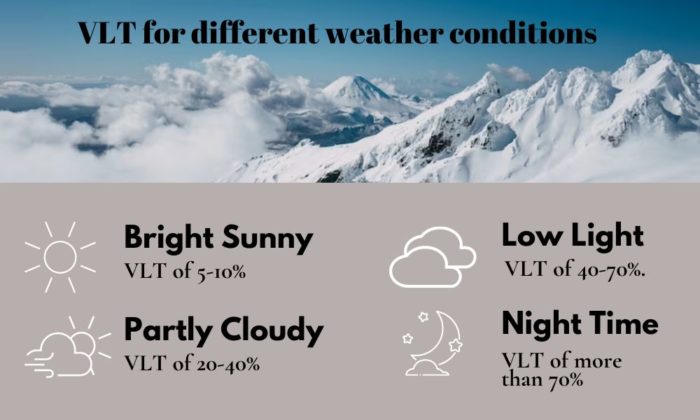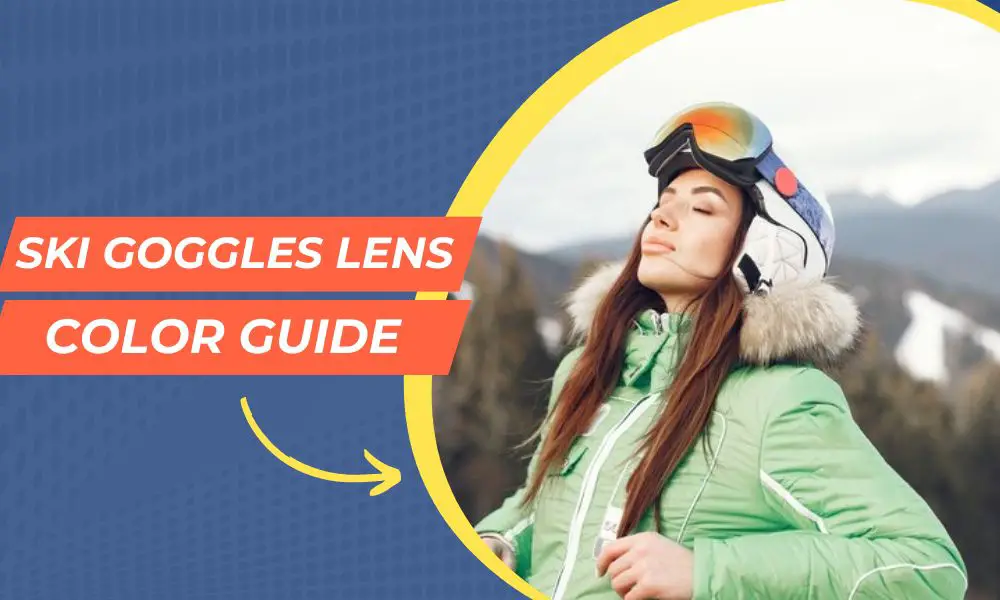This is one thing most people are confused about before starting skiing. It is not that difficult to figure out the color required in your goggles, but since you are a beginner, you need to know about it.
And you are at the correct place for that purpose! In this article, I am going to answer the most frequent doubts that beginners have in their minds. Thank me later!
Does Lens Color Matter In Ski Goggles?
The first thing you should know is lens color is a really important factor of lenses that determines many things based on the weather. So the question here should be why does lens color matter in ski goggles? And that is what I will be telling you here!
Lens color matters in ski goggles primarily because different colors of lenses enhance visibility in various lighting and weather conditions. The same lens color never works for every weather! You might have noticed that your light color lenses are not very effective when it comes to extreme sunny days. That is because they are not really compatible with each other. But on the other hand, dark lenses are very functional on sunny days. You see the law of opposite attraction working here!?
Our eyes perceive different colors of light differently, and ski goggles with specific lens colors are designed to manipulate the light entering your eyes to improve your vision and comfort on the slopes.

Light Absorption
Different lens colors absorb and transmit different wavelengths of light which affects how much light reaches your eyes and how much glare is reduced. For example, darker lenses absorb more light and are suitable for bright, sunny conditions, while lighter lenses allow more light in and are better for low-light or cloudy conditions.
Contrast Enhancement
Certain lens colors enhance contrast by selectively filtering out certain colors of light. It can help you differentiate between different terrains on the snow like the bumps and the ridges.
Depth Perception
Depth perception is important for estimating distances and riding on uneven terrains, especially in flat or low-light conditions.
Glare Reduction
Sometimes while skiing, glare from the sun or reflective surfaces like snow can be uncomfortable and even harmful to your eyes. Here some lens colors are effective in reducing glare and protecting your eyes.
Adaptation to Conditions
Different color lenses are apt for different weather conditions, drill this inside your mind! For this, interchangeable lens goggles are a good option. Also, see to it that the changing system is easy and not very complicated.
You need to choose lens colors that match your wants while skiing. Considering these things like VLT, lens tint, glare reduction, color contrasting, etc… will give you utter satisfaction with your skiing experience and you would not be able to deny it. If you are skating in a sunny environment where the sun will always be present, you cannot choose light-colored goggles because it matches the outfit you are wearing. Match your outfit with your goggles and not the other way around honey!
Role Of VLT And Lens Color
VLT refers to the percentage of visible light that is allowed to pass through a lens. The VLT value is directly related to the lens color and its ability to filter light. It plays a crucial role in ski goggle lenses and enhances your performance in various lighting conditions.
VLT and lens color are like coal and matchstick. One’s function cannot be determined without the other getting involved. Did you get the example?
The VLT value of a lens indicates how much light is transmitted through it. A lower VLT percentage means less light is allowed to pass through, making the lens darker. Similarly, a higher VLT percentage indicates more passing of light, resulting in a lighter lens.
Just like lens colors, different VLT percentages are suitable for different lighting conditions:
Low VLT with darker lens colors:
Lenses with low VLT percentages (e.g. 5-20%) are used for bright and sunny conditions. They relieve the straining of your eyes and thus reduce eye pain too.
Medium VLT
Lenses with medium VLT percentages (e.g. 20-40%) are versatile. They handle a mix of sun and clouds without being too dark or too light.
High VLT with lighter lens color
Lenses with high VLT percentages (e.g., 40% and above) are suitable for overcast, foggy, or low-light conditions. They allow more light to enter your eyes, enhancing visibility when the environment is dim.
As I already mentioned above when choosing ski goggle lenses, considering both VLT level and lens color helps you select the right lens for the conditions you’ll face.
This is a very important point, it may not help you in writing exams but definitely while skiing! Using ski goggle lenses with appropriate VLT values and colors increases safety by improving visibility. When selecting ski goggles, consider the anticipated conditions and choose lenses with the right VLT values and colors to optimize your visibility and overall performance on the slopes. You can also refer to my article where I have discussed more on the features of VLT and how it works in the goggles.
Different Types Of Color Tints In Ski Goggles

Do you buy a car before you have learned how to drive? You do not, I suppose, because nobody is that stupid. Just like that, unless and until you do not know the options available and what they are used for, how are you going to know if it is suitable for you or not?
One thing let me tell you, ski goggle lenses come in an en-number of color tints. And each of them is designed to enhance visibility and performance in different lighting and weather conditions.
1. Black/Gray Tint
As I already told you, dark-colored lenses are ideal for bright conditions. They are the best and the sole option for sunny days! They reduce light transmission, effectively block out intense sunlight and reduce glare. Gray tints offer true color perception, making them suitable for maintaining natural color visibility while providing protection against sunlight.
2. Brown/Bronze Tint
There aren’t many people who dare to ski under overcast skies, but if you are one of them then you should essentially have the brown-tinted lens! These lenses enhance contrast and depth perception and thus help largely in partly cloudy conditions.
3. Amber/Orange Tint
If you are someone who cannot stop skiing regardless of the weather outside, this is it! Amber or orange-tinted lenses are versatile options that work well in so many different conditions! They enhance contrast for partly cloudy to overcast days, improve visibility by increasing contrast in flat conditions and reduce glare on sunny days. What else do you need from a lens!? This color saves you the energy of swapping through various lenses whenever there is a slight change in weather. And do I need to mention that you also save a lot of money too by investing in an orange lens?
4. Rose/Pink Tint
Do not think these are for girls. These lenses are designed to excel in low-light conditions, such as early morning or late afternoon skiing. They enhance contrast and improve visibility in flat light, making it easier to identify details on the snow.
5. Yellow/Gold Tint
Yellow lenses are excellent for low-light and foggy conditions. I can already see a few people smiling from the screen reading the word foggy. I get it! These lenses provide more contrast making them a great choice when visibility is limited.
6. Clear Tint
Clear lenses are suitable for nighttime skiing or extremely low-light conditions as they allow maximum light transmission, ensuring good visibility. You might have understood that since there is an absence of natural light during the night, we need maximum light to pass through the lenses, which is a higher VLT. Clear lenses are also useful for protecting your eyes from wind and debris during nighttime skiing.
7. Blue Tint
Blue-tinted lenses are also used for reducing glare and providing visual comfort on sunny days.
8. Green Tint
Green-tinted lenses can offer a balance between contrast enhancement and color perception, typically worn while hiking.
Choose your lens color carefully based on the weather conditions you are living in and the desired features you want in your goggles. Below is a clear distinction made for you, please read it properly!
What Lens Color Is Suitable For What Weather Conditions?

1. Bright Sunny Days
Recommended Lens Color: Dark Gray, Black, Blue
You know that darker lens colors with low VLT percentages are ideal for blocking out intense sunlight and glare on bright sunny days. Darker lenses have a VLT of 5-10% which is perfect for bright conditions. And if your area of skiing has extremely bright sun rays, you should purchase goggles with lenses below 5% of VLT.
2. Partly Cloudy Conditions
Recommended Lens Color: Brown, Amber, Green
For the weather conditions when you cannot decide if you want hot coffee or cold coffee, these lens tints will suit you for skiing. By the way, even cold coffee tastes amazing on overcast days! The VLT should be between 20-40%.
3. Low Light Conditions (Overcast, Foggy, Flat Light)
Recommended Lens Color: Yellow, Gold, Rose, Pink
Lenses with yellow, gold, rose, or pink tints are excellent for low-light conditions, like rainy days when the sky is black. Or during foggy days when the sky is invisible. They increase contrast, to make it easier to see details on the snow and navigate through flat light situations. The VLT should be between 40-70%.
4. Night Time
Recommended Lens Color: Clear, Pink, Orange
These lenses allow maximum light transmission, which is crucial for skiing at night when natural light is minimal. They provide visibility without altering color perception. The VLT in these lenses should be more than 70%.
Note that, for added versatility, consider investing in ski goggles with interchangeable lenses.
Conclusion
I hope now you know everything about lens tints. I hope that you have it figured out if you need a darker lens tint or a lighter one.
Also, there are mirror coatings available for people who are a skier by day and a skier by night too. These coatings enhance the performance of goggles by reducing glare and increasing visual comfort. If your goggles do not already come with mirror coating then you can install them. They cause no problem at night time but help you immensely in the daytime!
So I hope this article helped you choose the lens tint which is suitable for you! Good luck skiing!

